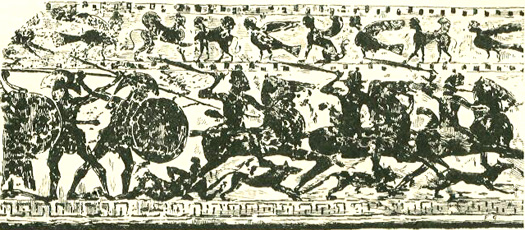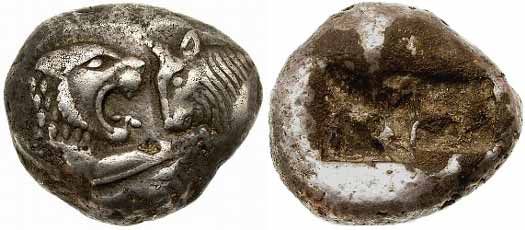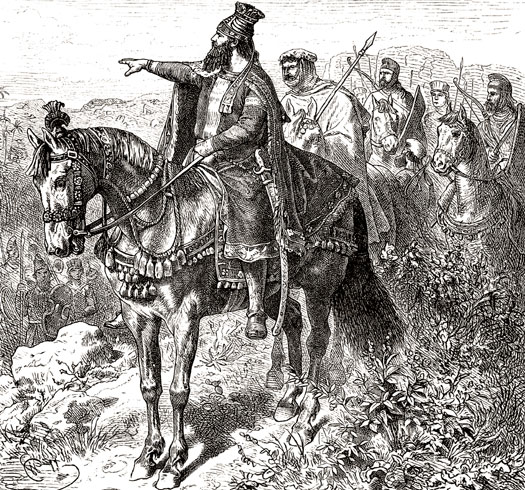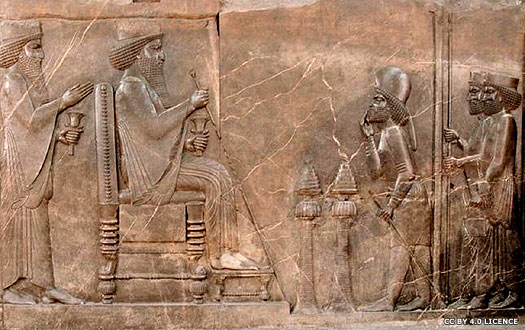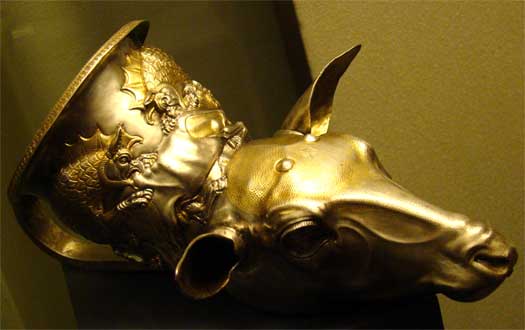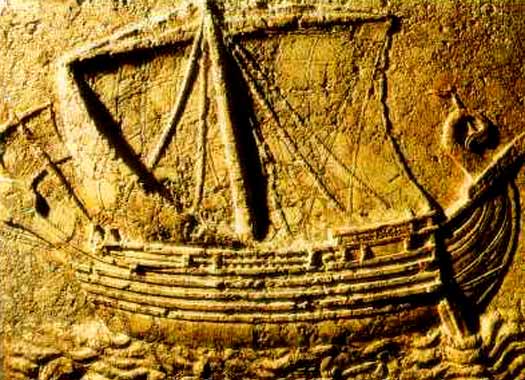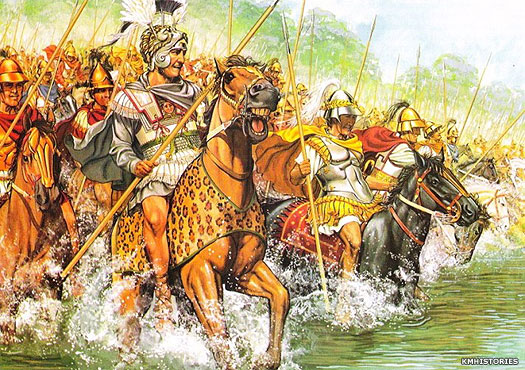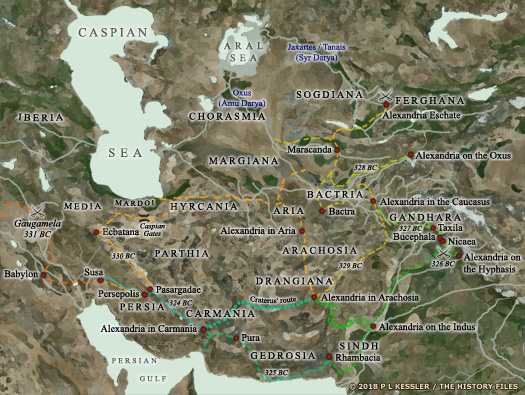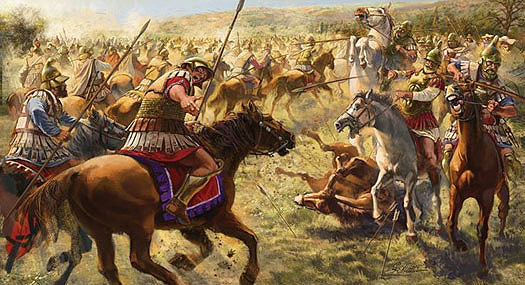
| MAEONIA AND LYDIA c.13th Century - 547 BC :
Situated in western Anatolia, in the second millennium BC Maeonia had been a Hittite territory within the subjected lands of Arzawa. The language spoken by its inhabitants was closely related to the South Indo-European Luwian which was spoken all around them, but perhaps with minor differences. The Lydians are often recognised as being a separate group of South Indo-European-speakers. Herodotus states that the nearby Mysians were of the same stock as the Lydians. Potential support for this comes from the fact that the two were always stationed together in the later Persian armies (although that could also be due to the fact that their home states were similarly close together).
As Hittite power collapsed during the thirteenth century BC, Maeonia became an independent neo-Hittite kingdom. Independence didn't last for long, however, as it soon fell to the Heraclidae (the Mycenaean Greeks under Heracles) some time after they defeated Troy. Although Mycenaean civilisation disappeared from most of Greece following the Dorian invasions, Lydia survived with its capital at Sardis. Unfortunately, none of the kingdom's history is datable until the accession of Gyges in 685 BC, while its traditions, mythology and rituals have been lost, leaving us to rely on Greek mythology for its earliest events.
Ephesus, a few kilometres from Sardis, near the coast, was later a major city in the Roman world, being an important centre for early Christianity, as well as home to a gladiator school.
(Additional information from External Link: the Dictionary of Greek and Roman Geography, William Smith (Ed, 1854).)
1300s BC :
The first Mycenaean Greek settlements are founded along the coastline of western Anatolia. Indo-European Hittite and Luwian peoples still govern the territory however, probably from the state of Arzawa.
A bronze seal written in the almost universal Anatolian language of Luwian which was discovered at Troy in 1995 c.1200 BC :
The weakened Hittite empire is destroyed, and the former subjects of western Anatolia form a neo-Hittite state called Maeonia. Herodotus claims that colonists from this state land in Etruria around this time and become the Etruscans.
Atyad Kings of Maeonia / Maionia (Tantalids) :
The information on Maeonia before the seventh century BC comes from sources such as Herodotus. He gives the founder and namesake of the kingdom, Manes, as the first king of Maeonia, with a son named Atys (Atyllus). Other sources, such as Strabo, name Tmolus and his son Tantalus as kings of the region at the same time, ruling from Sipylus (Mount Sipylus, near Manisa and Izmir in western Anatolia). As Omphale is shown as a member of both families, the probability is that they are identical.
The region was on the edge of late Hittite territory, within former Arzawa, and its Indo-European Maeonian kings were neo-Hittites who ruled independently after the empire collapsed. The rulers are all semi-legendary figures.
(Additional information from The Histories, Herodotus (Penguin, 1996).)
c.1200? BC :
Manes / Tmolus : Founder of Maeonia. Gored to death by a bull.
c.1195 - 1173? BC :
Omphale : Wife. Reigned after Manes' death.
c.1190? BC :
Atys / Tantalus : Son of Tmolus and Plouto. m Dione.
Herodotus states that in the time of Atys there is a 'great scarcity [of food] throughout the whole land of Lydia', which appears to be a remembrance of the widescale famine that affects the region at the end of the thirteenth century BC. The famine lasts for at least eighteen years, during which the population copes as best it can on what is in effect half-rations. In the end, Atys divides the populace in two, and instructs one of his sons, Tyrsenos, to command half in a migration to new lands. Heading west they become known after their new king - as Tyrsenians - finding refuge in the 'land of the Ombricans'. These would be Umbrians, an Italic tribe which, during the Iron Age, occupies much of the mountainous spine of central and northern Italy. The Tyrenians settle to the west of them, becoming a people known as the Etruscans.
Tantalus is a name from Greek legend, ruling in Sipylus (Mount Sipylus), otherwise known as the kingdom of Tantalus. It seems likely that he and Atys are one and the same. To test the gods, he kills his son, Pelops, and they revive him.
Pelops : Son. m Hippodamia, dau of Oenomaus. King of Pisa.
The sons of Pelops, Atreus and Thyestes, fight between each other for the kingdom of Mycenae. Atreus wins and becomes king. He founds the dynasty at Mycenae which produces Agamemnon but which is cursed to suffer misfortune.
? - c.1183 BC :
Lydus / Broteas : Brother. Went mad and threw himself into a fire.
Died c.1200 BC :
Tantalus (of Pisa) : Son. m Clytemnestra & killed by Agamemnon of Mycenae.
c.1193 - 1183 BC :
Mesthles and Antiphus, the sons of Telaemenes, lead the Maeonian contingent to the Trojan War on the side of Troy.
c.1183 - 1100 BC :
Maeonia becomes a Heraclid post-Mycenaean, Ionic colony after the defeat of Troy. It is unclear whether the new masters are part of the Ionian League, but it seems that Omphale still rules for a time (perhaps as a vassal?).
Following the collapse of Mycenaean civilisation in Greece by around 1140 BC, it seems that the Mycenaean settlers in Maeonia either take over the kingdom, or replace it with one of their own in the same region.
Heraclid Kings of Maeonia / Lydia (Tylonids) :
Following the Mycenaean conquest of Troy, the descendants of semi-legendary Heracles eventually seem to have established the capital at Hyde (perhaps the name of the region in which Sardis was located). They were bordered by the Ionian League of city states to the west and Phrygia to the north-east. At some point up to the reign of Gyges in circa 685 BC Maeonia became Lydia after the last king of the previous dynasty. The change in the kingdom's name supports a level of social change in the region which could include the replacement of a Maeonian royal house for a Mycenaean one, or perhaps the Heraclids for the later Mermnads.
The Heraclids comprised twenty-two kings who reigned for a total of 505 years, according to Herodotus. They were descended from a liaison between Omphale and Heracles (known as Tylon to the Lydians), although Herodotus suggests that the Lydian kings may not have descended from Omphale at all. Perhaps this was a later Mycenaean attempt at establishing the legitimacy of their rule.
Lydian warriors were famous archers by the sixth century BC who were known by the Judeans (Jeremiah 46:9). In fact the early Israelites even claimed to have an ancestor figure named Lud who was the founder of the Lydians. The fact that the language of the Lydians can clearly be traced renders this claim an empty one. Despite the Greek influences, their language remained Lydian, an Indo-European language which was related to Luwian and Hittite, which finally became extinct during the first century BC.
(Information by Peter Kessler, with additional information by Wayne McCleese (the list of Abraham's ancestors).)
c.1183 BC :
Heracles / Herakles : Married Omphale, widow of Manes, but apparently didn't rule.
c.1183 - 1173 BC :
In Greek mythology, Omphale is the ruler of Lydia, whom Heracles is required to serve for a period of time (his various adventures also include restoring his brother as ruler of Laconia). During his time in Lydia Heracles enslaves the Itones, kills Syleus (who had been forcing passers-by to hoe his vineyard), and captures the Cercopes. One of his companions, Autolycus, is reputed to refound the port settlement of Sinope on the Black Sea coast.
c.1160? BC :
Alcaeus / Alkaios : Son. Later chroniclers named these three as kings of Lydia.
c.1140? BC :
Belus / Belos : Son.
c.1120? BC :
Ninus / Ninos : Son.
c.1100? BC :
Agron : Son. First Heraclid king of Lydia.
c.1100 - 795 BC :
Seventeen unknown kings over 505 years, all succeeding each other in an unbroken line of descent.
795 - 759 BC :
Ardys I / Ardysus I : Son of his predecessor.
759 - 745 BC :
Alyattes I : Son.
745 - 733 BC :
Meles / Myrsus : Son.
733 - 716 BC :
Candaules / Myrsilus : Son. Murdered by former friend Gyges.
731 (695) BC :
Phrygia loses the territory of Pergamum to Lydia about 695 BC, seemingly upon the defeat and suicide of King Midas III. Five years later, nomadic Cimmerian warriors overrun Phrygia and sack the capital, Gordion. However, this Cimmerian sacking is also stated to be the cause of Midas committing suicide, so the situation seems to be mildly confused. Either way, Lydia becomes the dominant power in western Anatolia whilst Phrygia is eclipsed.
716 (685) BC :
Gyges murders Candaules and usurps the kingdom, marrying Candaules' widow to cement his claim to the throne. From this point onwards, dates are calculated against those of Assyrian history.
Mermnad Kings of Lydia :
From the reign of Gyges onwards the kingdom is fully historical. However, the dates for this dynasty have never been determined with certainty. The traditional dates are derived from Herodotus, who gives the lengths of each king's reign; but these have been questioned by modern scholars on the basis of matching events with confirmed dates in Assyrian history. The dates calculated against Assyrian history are shown here, with the traditional dates in the notes.
After murdering his former friend, Candaules, and taking his Heraclid throne, Gyges founded a new capital at Sardis, a few miles further inland from Sipylus. During his reign and afterwards, Lydia became the leading power in western Anatolia and held onto that position, now that Phrygia had been severely reduced in strength following the sacking of its capital city. The newly-expanded Lydia quickly incorporated territory that saw its borders stretch from the Greek fringe on the western coast as far as the River Halys in the east. It was at this river that the Lydians came to blows with the Medians in 590 BC. To the south of this, the rulers of Khilakku seem to have absorbed the remaining principalities of eastern Anatolia.
Lydia is also noted as the birthplace of coinage circa 660 BC, and the kingdom had subjugated Caria by the sixth century.
(Additional information from The Persian Empire, J M Cook (1983), and from External Links: Encyclopaedia Britannica, and Thrasybulus of of Miletus (Hellenica World).)
c.685 - 644 BC :
Gyges (Guggu) : (716-678 BC). Married Candaules' widow. Reigned 38 years.
652 BC :
One serious invasion of Anatolia by Cimmerians has already been repulsed, with the states or regions of Hilakku, Lydia, and Tabal requesting help from Assyria. Now the Cimmerians return (leader unknown). King Gyges of Lydia is killed during a second attack. His capital of Sardis is captured, all except the citadel which manages to hold out. The fact that it does suggests either that either the Cimmerians do not hang around for long after their victory or that (as before) they are moved along by an Assyrian force (with Ardys II of Lydia helping them on their way at the point of a sword).
This image shows Cimmerians battling early Greeks - prior to the advent of accepted 'Classical' Greece - with the mounted Cimmerians warriors apparently being accompanied by their dogs Excavations at the site of Sardis later discover a destruction layer that appears to be associated with this event. The dating is clearly off when matched against the dates given here for Gyges, or even the alternative dates shown in parentheses in his notes, but that is not unusual when many events are being pieced together from various ancient inscriptions, tablets, and 'annals'.
c.644 - 615 BC :
Ardys II / Ardysus II : (678-c.625 BC). Son. Reigned 49 years.
c.626 - 590 BC :
Lydia seizes control of the kingdom of Phrygia.
c.615 - 610 BC :
Sadyattes : (629-617 BC). Son. Reigned 12 years.
c.609/5 - 598/4 BC :
An eleven year-long war is triggered against the city of Miletus in Caria around 623 BC. According to Herodotus, Thrasybulus of Miletus wards off Sadyattes and then tricks his successor, Alyattes, into agreeing peace following stalemate on the battlefield.
c.610 - 560 BC :
Alyattes II : (617-560 BC). Son. Reigned 57 years.
c.600 BC :
The Lydians conquer the southern Anatolian region of Pamphylia and expand the kingdom in all directions. This brings them into direct contact with Greek settlers in western Anatolia. During this period the kingdom is bordered in the north-east by Scythians and Cimmerians, tribes which are aggressive and unruly, although most of their antagonism is directed towards Assyria.
585 BC :
Alyattes loses the Battle of the Eclipse to Media in a fifteen year war which is otherwise relatively evenly matched. Lydia expands in his reign to form an empire that covers all of western Anatolia and includes Paphlagonia. The end of the war signals the start of closer ties between the two kingdoms. Alyattes II of Lydia gives his daughter in marriage to Astyages, son of Cyaxares.
560 - 547 BC :
Croesus / Kroisos : (560-546 BC). Son. Reigned 14 years.
547 BC :
Croesus is the source of the term 'rich as Croesus'. His powerful kingdom now finds itself neighboured across the River Halys by the recently-established Persian empire which has overthrown his own brother-in-law, Astyages, as ruler of the Medes. The Persian ruler, Cyrus, may also be making overtures to the Ionian Greeks behind his back, attempting to destabilise the Lydian domains. Croesus crosses the Halys with his formidable cavalry and captures Pteria but is forced back by Cyrus after an indecisive battle.
Thinking the campaigning season over, he dismisses his mercenaries and is surprised when Cyrus follows him. The Battle of the Lydian Plain sees a hurriedly-assembled Lydian force scattered. The capital at Sardis falls in fourteen days and Croesus is taken as a prisoner. Lydia is absorbed into the empire and becomes the centre of a satrapy named Sparda. The empire of Croesus had included various neighbouring territories, including Pamphylia and Paphlagonia, and Persia takes these too.
Croesus was reputed to have minted the first gold and silver coins - two sides of such a silver coin are shown here - and was famous for his wealth until he became too ambitious and was conquered by the growing Persian empire Persian
Satraps of Sparda (Lydia & Sardis) :
The attempt in 547 BC by the kingdom of Lydia to invade Anatolian lands which now belonged to the Persian empire saw an appropriate Persian response. Cyrus the Great invaded Lydia and crushed it, and then proceeded to capture the rest of Anatolia too. The kingdom of Phrygia and the minor city states of Caria also fell between 549-546 BC. Following that, a Persian layer of administration was introduced to replace the lost kingships. Fortunately this is the best-documented of all the great satrapies, providing a good deal of information and extrapolation to help detail other satrapies. Its capital was the old Lydian metropolis of Sardis (Sparda to the Persians).
The new great satrapy of Sparda initially controlled not only the territory of the former kingdom of Lydia, but also that of Katpatuka which had been the initial target of Lydia's aggression, and the reason that Lydia had been conquered in the first place. Perhaps Cyrus enjoyed the irony of the situation. More specifically, the great satrapy of Sparda consisted of the central minor satrapy of Lydia around its capital of Sardis, and the more peripheral minor satrapies of Hellespontine Phrygia (with its capital at Daskyleion), Greater Phrygia, KarkÔ, and Skudra (between 512-479 BC, at which time Persian control was shrugged off there).
The former kingdom and now-region of Mysia was rarely important enough to warrant many further mentions in history, but subsequent references to it are handled under the Lydian satraps. As a minor satrapy, KarkÔ also oversaw the administration of neighbouring Lykia as an even more minor satrapy. The Ionian and Aeolian regions did not strike the Persians as being clearly defined geopolitical entities, with the result that various descriptions are used for them from the very beginning of Achaemenid occupation. There was no Ionian satrapy, though, even if Darius I did organise them into a nebulous province called Yauna. The islands were administered directly from Sparda.
Demaratus was a king of Sparta who had been exiled for being obstructive and churlish (but perhaps a greater motive was his questionable parentage). He fled to Persia where he advised Darius I and then Xerxes on Greek affairs, and accompanied the Persian army in its invasion of Greece in 480 BC. When that failed, Xerxes made him governor of the cities of Pergamum, Teuthrania, and Halisarna within the province of Mysia, in the Lydian satrapy. His descendants inherited the office over the subsequent eighty years or so.
(Information by Peter Kessler, with additional information from The Persian Empire, J M Cook (1983), from The Histories, Herodotus (Penguin, 1996), from Anabasis Alexandri, Arrian of Nicomedia, from Panyassis of Halikarnassos: Text and Commentary, PanÝasis, from The Oxford Classical Dictionary, Simon Hornblower, Antony Spawforth, & Esther Eidinow (Oxford University Press, 2012), from A Dictionary of Greek and Roman Biography and Mythology, William Smith (Ed), and from External Links: Encyclopaedia Iranica, and Lives of Eminent Commanders, Cornelius Nepos (1886 Edition), and The Wonder Of Mausoleum At Halicarnassus Planned To Be 'Restituted' (Greece High Definition).)
549 - 546 BC :
The defeat of the Medes opens the floodgates for Cyrus the Great with a wave of conquests, beginning with Cilicia in 549 BC. Harpagus, a Median of the royal house and the main cause of the Median defeat, commands Cyrus' army in Anatolia, conquering it between 547-546 BC.
Cyrus the Great freed the Indo-Iranian Parsua people from Median domination to establish a nation that is recognisable to this day, and an empire that provided the basis for the vast territories that were later ruled by Alexander the Great Taken during this campaign are Armenia, Caria, Lycia, Lydia, Paphlagonia, Phrygia, and Tabal (Cappadocia), and Harpagus and his descendants reign thereafter in the satrapy of KarkÔ (Caria) and Lykia (Lycia) (and apparently Cilicia too) as satraps. Harpagus also takes on the satrapy of Sparda following the death of its satrap around 544 BC.
546 - 545 BC :
Tabalus : Persian satrap.
545 - c.544 BC :
Mazares : A Mede. Satrap. Died in office.
c.544 - ? BC :
Harpagus / Hypargus : A Mede. Satrap of KarkÔ, Lykia, & Sparda.
bef 530 - c.520 BC :
Oroetus / Oroites : Persian satrap of Sparda & Phrygia (Daskyleion). Assassinated.
c.520 BC :
Oroetus has remained entirely unmoved during the many revolts against the new Persian king, Darius, providing neither help nor hindrance. However, he has already lured Polycrates, tyrant of the island of Samos, to his death and now takes the opportunity to avenge an insult by removing Mitrobates, satrap of Hellespontine Phrygia, and seizing the province for himself. When Darius sends him orders Oroetus kills the messenger, so Darius dispatches a 'volunteer', Bagaeus, who assassinates the rogue satrap.
The brother of Polycrates, Syloson, is restored to Samos by Darius as a Persian subject (in or after 517 BC). Two other Greek islands, Chios and Lesbos, also submit to the Persians, probably giving Darius his rather nebulous province of Yauna (Ionia, the islands of the Ionian or East Greeks). Bagaeus, his mission successfully concluded, becomes satrap of Sparda.
The central relief of the North Stairs of the Apadana in Persepolis, now in the Archaeological Museum in Tehran, shows Darius I (the Great) on his royal throne (External Link: Creative Commons Licence 4.0 International) c.520 - ? BC :
Bagaeus / Bagaios : Persian satrap of Sparda. Assassin of Oroetus.
fl 517 BC :
Otanes : Persian satrap of Sparda. Died?
Otanes had been one of the seven who had removed the false Smerdis from the Persian throne in 522 BC. In fact he had been the instigator of a meeting which had led to the murder and the establishment of a firmly centralised monarchy to replace the looser federal structure that Cyrus had initiated. In response for not opposing Darius I in his claim for the throne (Otanes has an equal, if not superior, claim as the brother-in-law of Cyrus the Great), Otanes is granted the satrapy of Sparda with orders to conquer the Greek island of Samos. This is when Syloson is appointed as the ruler of the island.
fl 515? BC :
Gadates : Persian satrap of Sparda. Recipient of the 'Gadates Letter'.
Gadates is the recipient of the 'Gadates Letter' from Darius. It reprimands him for curtailing the privileges of the priests of Apollo at Magnesia on the Maeander, but commends him for introducing fruit trees from Abarnahara (Syria). Although Gadates' position is not mentioned, the location of his areas of influence suggest him as a satrap of Sparda at a point between the assassination of Oroetus and Darius' Scythian campaign of 513 BC.
513 - 492 BC :
Artaphernes I : Brother of Darius I. Persian satrap of Sparda.
513 - 512 BC :
The Persians enter northern Greece, with Darius conquering Thrace south of the Danube. They hold onto it for about fifty years, possibly until they are forced out of Macedonia by Alexander I. This territory is subjoined to the great satrapy of Sparda, most likely as the minor satrapy of Skudra, with King Amyntas of Macedon as its local governor. Colchis on the eastern shore of the Black Sea is taken during the same campaign and is created a minor satrapy under the oversight of Armina.
The Odrissae of Thrace were a union of tribes which formed towards the end of Persian domination of the region, quite possibly being responsible for weakening the empire's hold on the rural districts 507 BC :
The Athenians are threatened with attack on three fronts by hostile Greek neighbours. They send to Sardis, asking for a Persian alliance. This involves the Greek envoys recognising Persian suzerainty, something which the Athenians promptly disavow after the emergency is over. The Persians probably see it differently, viewing the Athenians as rebellious subjects when they renounce the alliance, what Darius the Great calls 'the Lie'.
c.500 BC :
Aristagoras, tyrant of Miletus, sees the opportunity for self-aggrandisement in the restoration of some exiled oligarchs to the large, rich island of Naxos. He approaches Satrap Artaphernes for support and, with agreement from Darius, a fleet of two hundred triremes is sent to Naxos. The expedition fails in its goal when Naxos is warned by Greek members of the fleet, but Aristagoras has seen an opportunity to rid himself (and his detained uncle, Histiaios) of Persian control.
499 - 493 BC :
The Ionian Greeks of western Anatolia and the islands of the eastern Aegean which are under Persian hegemony now rise in the Ionian Revolt. The Carians join in and, with the Ionians being led by Aristagoras, tyrant of Miletus, they inflict heavy losses on the Persians. Similar revolts arise in Aeolis, Salamis, and Doris as the Greeks see a chance for freedom. Athens sends troops to aid the Ionian islands but the Persians gradually gain the upper hand and the revolt crumbles.
The end of the revolt probably sees the Persians breath a sigh of relief that these troublesome Greeks are back under proper control. Aristagoras, the main leader of the revolt, flees to Thrace in the hopes of setting up a colony outside Persia's control, but he is killed in a battle against a nearby town. His chosen successor in Miletus is Pythagoras, but Darius the Great kills the men of the city and enslaves its women and children, ensuring that the city is deserted. For its part in the revolt, Athens will soon face the first of two Persian invasions of Greece itself.
The Athenian politician and general Themistocles (archon in 493-492 BC) helped build up the city's navy so that it was a force to be reckoned with when the Persians invaded Greece - thanks to this the Athenian Admiral Cimon was able to defeat the Persians on the banks of the River Eurymedon in Pamphylia in 465 BC 492 - ? BC :
Mardonius : Persian satrap of Sparda.
482 - aft 480 BC :
Artaphernes II : Satrap. Son of Artaphernes I.
480 - 479 BC :
Invading Greece in 480 BC, during the Greco-Persian War the Persians subdue the Thracian tribes (except for the Satrai, precursors to the Bessoi) and the Macedonians. Then the vast army of Xerxes makes its way southwards and is swiftly engaged by Athens and Sparta in the Vale of Tempe. The Persians are subsequently stymied by King Leonidas at Thermopylae and then defeated by the Delian League. The naval Battle of Salamis is a resounding Greek victory. It leaves much of the Persian navy destroyed and Xerxes is forced to retreat to Asia.
Many of the Persian governors of the north-western imperial provinces are defeated by Greeks and expelled, and this soon includes those of Skudra. Colchis has probably also been lost to the Persians by now, and Sardis may be too close to the new reach of the Greek navy to be safe for a satrap. The satrapal seat may be moved further inland, perhaps to Kelainai, although the satrapy generally becomes obscure during this period. It is not until the Peace of Kallias in 449 BC that Sardis again becomes safe for the Persians.
469 BC :
Athenian statesman and general, Kimon (or Cimon) leads an allied Greek fleet to KarkÔ. The attack focuses on destroying Persian strongholds as far as Phaselis on the border with Pamphylia. The response from Xerxes is to send an army under Pherendates to Pamphylia and a joint fleet from Khilakku and Phoenicia (rebuilt after the loss of the Persian fleet in 479 BC) under the command of Tithraustes, a bastard son of Xerxes. The new fleet is destroyed and captured, and the Persian army is utterly defeated.
This first century AD stone carving reflects Phoenician ship design from an earlier age, with them providing the majority of the naval forces for the Persian empire bef 440 - 415 BC :
Pissouthnes : Persian satrap of Sparda.
c.415 BC :
Pissouthnes has been bolstering his position by hiring Greek mercenaries, perhaps as a response to the uncertainty in the empire following the death of Artaxerxes I. Pissouthnes himself is a legitimate heir to the throne and knows that he may be placed in a position in which he either has to launch a claim of his own or be destroyed by an opponent. He appears to launch his bid during the rather more stable reign of Darius II. Tissaphernes, son of Hydarnes, is sent to deal with the 'revolt' and take over as satrap. Pissouthnes' son, Amorges, continues the revolt on the coast with Athenian support between about 414-412 BC.
c.415 - 408 BC :
Tissaphernes : Descendant of Hydarnes, satrap of Media c.499 BC.
408 BC :
During such periods, the satrap of Sparda becomes directly responsible for the entire region, including Katpatuka. He also vies for full control of Lykia, often against his own peers. Tissaphernes certainly attempts this during his period of office.
408 - 401 BC :
Cyrus the Younger : Brother of Artaxerxes II of Persia. In Pergamum & Sparda.
400 - 395 BC :
Tissaphernes : Restored to office. Also governed KarkÔ. Executed.
395 BC :
KarkÔ becomes a satrapy in its own right, upon the execution of Tissaphernes by his replacement, Tithraustes. Its first satrap is a Carian of a leading family, possibly Hyssaldomos, previously a dynastic ruler of Mylasa. If so then he is almost immediately succeeded by his son, Hekatomnos. The latter spawns a dynasty which governs for almost half a century.
c.395 - 393? BC :
Tithraustes : Persian satrap. Transferred to Egypt campaign (389 BC).
c.393 - 392 BC :
Tiribazos / Tiribazus : Persian satrap of Sparda. Formerly of W Armina. Replaced.
389 - 387 BC :
Abrocomas (satrap of Ebir-nāri & Phoenicia) joins two other Persian army commanders - Pharnabazus (not to be confused with Pharnabazus II of Phrygia) and Tithraustes (former satrap of Sparda) - in the attempted reconquest of Egypt. Their efforts meet with little success as the Egyptians have relearned how to defend their country.
The remains of a fortress which was probably built by Pharaoh Psamtik in the late seventh century BC to secure Egypt's north-eastern border show that, although Egypt's ability to defend its borders were much diminished, it could still deliver invaders a painful sting c.392 - ? BC :
Struthas : Persian satrap of Sparda.
c.388 - 380 BC :
Tiribazos / Tiribazus : Restored to Sparda. Rebelled in 365 BC. Killed.
381 BC :
Persia regains control of Salamis in 381 BC after ten years of effort, with Tiribazos leading the naval side of operations. Salamis continues to be governed by its would-be independent king, Evagoras, now as client king, while Tiribazos is impeached by Orontes, commander of the land forces. He is temporarily jailed until his name has been cleared. By then he has lost his satrapal seat for the second time.
fl 367 BC :
Autophradates : Persian satrap of Sparda (with KarkÔ). Rebelled c.362 BC.
367 - 358 BC :
Ariobarzanus, satrap of Phrygia, joins Datames, satrap of Khilakku and Katpatuka and independent ruler of Paphlagonia, in revolt against Artaxerxes II. Autophradates, satrap of Sparda, is ordered to suppress the rebellion and he manages to expel Ariobarzanes from the greater part of his satrapy. In 365 BC, Athens sends thirty ships and 8,000 mercenaries to aid Ariobarzanus. He rewards Athens with the gift of Sestos and Crithote, cities on the Thracian Chersonesus.
Soon all of Asia Minor (Anatolia) revolts against Artaxerxes II, with Datames also having seized Paphlagonia. In 362 BC, even Autophradates is driven to join the rebels. At the same time, the patience of the redoubtable Tiribazos with the king has run out. He conspires with Darius, the crown prince, to remove Artaxerxes II but the plot is discovered. Darius is executed and Tiribazos goes down fighting. Sparta, and also Takh˘s, pharaoh of Egypt, send substantial help to the rebels. Two years later, in 360 BC, Ariobarzanes is betrayed by his son, Mithridates, and is executed. The satrapal revolt is finally suppressed in 359-358 BC.
? - 334 BC :
Spithridates : Persian satrap of Sparda. Mortally wounded in battle.
334 - 323 BC :
In 334 BC Alexander of Macedon launches his campaign into the Persian empire by crossing the Dardanelles. The first battle is fought on the River Graneikos (Granicus), eighty kilometres (fifty miles) to the east. Spithridates joins his king at the battle and is involved in the fighting to prevent Alexander from reaching Darius. Spithridates aims a blow at Alexander's back, but his hand is cut off by Clitus the Black (later Greek satrap of Bactria).
Alexander the Great crossed the River Graneikos (or Granicus) in 334 BC to spark a direct face-off with the Persians that had been brewing for generations, and his victory in battle near the river sent shockwaves through the Persian empire The Persian defeat forces Satrap Arsites of Daskyleion to commit suicide. Sparda surrenders but KarkÔ's satrap holds out in the fortress of Halicarnassus with the Persian General Memnon. The fortress is blockaded and Alexander moves on to fight the Lykian mountain folk during the winter when they cannot take refuge in those mountains.
Argead Dynasty in Lydia & Sardis :
The Argead were the ruling family and founders of Macedonia who reached their greatest extent under Alexander the Great and his two successors before the kingdom broke up into several Hellenic sections. Following Alexander's conquest of the Persian holdings in Anatolia and Syria between 334-331 BC, the Greek empire ruled the region until Alexander's death in 323 BC and the subsequent regency period which ended in 310 BC. Alexander's successors held no real power, being mere figureheads for the generals who really held control of Alexander's empire. Following that latter period and during the course of several wars, Anatolia was divided between Cassander of Macedonia, the Lysimachian empire, and the Antigonid empire.
Under Persian control, Lydia and the city of Sardis had formed the centre of the highest level of satrapal governance of Anatolia under the name Sparda. This initially controlled not only the territory of the former kingdom of Lydia, but also that of Cappadocia and the more peripheral minor satrapies of the two Phrygian regions (one of which had a capital at Daskyleion), plus those of Caria, and a region of Thrace which was labelled Skudra (but only between 512-479 BC).
Anatolia under the Persians was a troublesome command. The location of frequent uprisings and rebellions, some of these were extremely serious for the Persian king of the time, often threatening his position on the throne. Quite often it seems to have been the region's Greek populace that was behind the trouble, the Ionians of the islands, just as often aided and abetted by those on the Greek mainland. When Alexander the Great arrived in 334 BC, one serious battle at River Graneikos (Granicus) served to unsettle the already-fragile state of Persian command. The Persian defeat forced Arsites of Daskyleion to commit suicide, Sparda surrendered, and Caria's satrap held out in the fortress of Halicarnassus with the Persian General Memnon. Alexander moved on to fight the Lycian mountain folk while leaving units behind to deal with the pockets of resistance.
(Information by Peter Kessler, with additional information from The Persian Empire, J M Cook (1983), from The Histories, Herodotus (Penguin, 1996), from Anabasis Alexandri, Arrian of Nicomedia, from Panyassis of Halikarnassos: Text and Commentary, PanÝasis, from The Oxford Classical Dictionary, Simon Hornblower, Antony Spawforth, & Esther Eidinow (Oxford University Press, 2012), from A Dictionary of Greek and Roman Biography and Mythology, William Smith (Ed), from The Generalship of Alexander the Great, J F C Fuller, from the Historical Dictionary of Ancient Greek Warfare, J Woronoff & I Spence, and from External Links: Encyclopaedia Iranica, and The Geography of Strabo (Loeb Classical Library Edition, 1932).)
334 - 323 BC :
Alexander III the Great : King of Macedonia. Conquered Persia.
323 - 317 BC :
Philip III Arrhidaeus : Feeble-minded half-brother of Alexander the Great.
317 - 310 BC :
Alexander IV of Macedonia : Infant son of Alexander the Great and Roxana.
334 - 323 BC :
Assander : Greek satrap. Later in Caria (323 BC).
334 BC :
With Persian KarkÔ's new satrap holding out in the fortress of Halicarnassus alongside the Persian General Memnon, Alexander sets up a blockade and moves on to fight the Lycian mountain folk during the winter when they cannot take refuge in those mountains. Ada, dispossessed satrap of KarkÔ, welcomes Alexander, besieges Halicarnassus for him, and is raised to the status of queen of Caria following her success in taking the city. Assander, now satrap of Lydia, is assigned as her protector, should she require one. He also succeeds her in Caria following what is presumably her death.
The route of Alexander's ongoing campaigns are shown in this map, with them leading him from Europe to Egypt, into Persia, and across the vastness of eastern Iran as far as the Pamir mountain range 323 BC :
Following the death of Alexander the Great, Menander is appointed satrap of Lydia, having only just arrived in Babylon with a draft of recruits for the army. Then the First War of the Diadochi (the successors - the generals of Alexander's army) sees civil war break out between the generals.
323 - 321 BC :
Menander : Greek satrap in support of Antigonids.
321 BC :
A fresh settlement of territories sees Menander being replaced by Cleitus, nicknamed 'the White' to distinguish him from the late Cleitus 'the Black' of Bactria. Presumably this is so that Menander can provide leadership during an Antigonid campaign against Eumenes in Cappadocia. Cleitus too provides service to the Antigonids.
321 - 317 BC :
Cleitus / Clitus 'The White' : Greek satrap in support of Antigonids. Killed in battle.
320 - c.180 BC :
Lydia becomes a battleground during the subsequent Wars of the Diadochi which end in 301 BC. A new agreement in 320 BC with Antipater makes him regent of the Macedonian empire and commander of the European section. The Antigonids see their eponymous ruler remain in charge of Lycia and Pamphylia, to which is added Lycaonia, Syria and Phoenicia, making Antigonus commander of the Asian section. Ptolemy retains Egypt, Lysimachus retains (Greater) Phrygia and Thrace, while the three murderers of Perdiccas - Seleucus, Peithon, and Antigenes - are given the former Persian provinces of Babylonia, Media, and Susiana respectively. Arrhidaeus, the former regent, receives Hellespontine Phrygia.
The Battle of Ipsus in 301 BC ended the drawn-out and destructive Wars of the Diadochi which decided how Alexander's empire would be divided Lydia's own status is less clear, but would seem to be part of the territories that are controlled by Antigonus until 301 BC. Then, as part of his Lysimachian empire, Lysimachus gains Ionia, Lydia, Phrygia, and the southern Black Sea coast of Asia Minor. Cilicia and Lycia are initially given to the brother of Cassander of Macedonia, Pleistarchus, but he is forced out in the following year by the new Antigonid ruler, Demetrius I Poliorcetes. The region soon also falls under the rule of the Lysimachian empire.
By the time of the death in battle of Lysimachus in 281 BC, Lydia has ceased to become important as an administrative centre, with its cities now generally part of larger empires that have different (and largely unknown) governmental arrangements.
c.180 - 133 BC :
Rome defeats the Seleucids in the Seleucid War, taking Asia Minor as a province in 188 BC. The Seleucid ally, Cappadocia, negotiates friendly terms with Rome, notably because Stratonice, the king's daughter, is about to marry the king of Pergamon, a Roman ally. Pergamon annexes the territory of Lydia and Pamphylia around this point in time, but both become Roman provinces in 133 BC.
Source :
https://www.historyfiles.co.uk/ |

